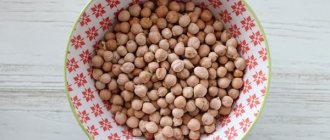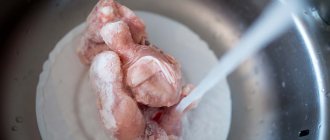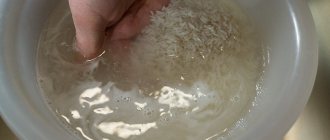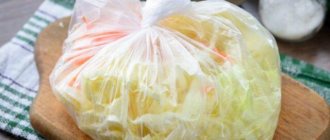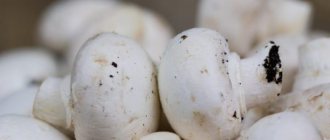Lifehacks
Products
Peking cabbage is a low-calorie product (only 16 kcal per 100 g) - you can eat almost kilograms and still lose weight. The vegetable contains a large amount of vitamins and coarse fibers that stimulate digestion, nourish the intestinal microflora and remove toxic substances from the body.
To retain all the benefits, it is important to properly prepare Chinese cabbage for cooking. We'll talk about this below. And “With Taste” has selected 5 proven recipes for salads and appetizers with this wonderful vegetable!
How to choose Chinese cabbage for salad?
How to choose Chinese cabbage
- Chinese cabbage leaves should not be limp or withered;
- the color of Chinese cabbage leaves, regardless of shade, is always rich;
- the lighter the Chinese cabbage, the juicier its leaves;
- green heads of Chinese cabbage will be less juicy due to fiber;
18 Mar
2022 Interesting materials:
How can a foreign citizen obtain a temporary residence permit? How to get a temporary residence permit under a quota? How can a citizen of Uzbekistan obtain a temporary residence permit in Moscow? How can an Armenian citizen obtain a temporary residence permit in Russia? How to get a temporary residence permit in Russia based on marriage? How to get a temporary residence permit in Russia? How to get s in lol? How to get a seedling from an old apple tree? How to get seeds from tulips? How to get chamomile seeds?
The importance of peeling a vegetable
All vegetables are processed before consumption. It is important to know how to peel cabbage, because the withered surface and pieces of dirt can cause harm to the human body. The process will not take much time if you choose the right vegetable.
Indicators of good quality are a pleasant smell, a small head of cabbage with light and fresh leaves, characterized by medium density and elasticity.
Products with frozen or dried areas should be avoided. The color of the head of cabbage also matters; the darker and greener it is, the less juice the cabbage contains.
Which parts of the plant are not edible?
The top of the vegetable may contain residual soil or moisture. Over time, it still turns yellow and dries out, so when cleaning, 3-4 sheets are torn off and thrown away immediately. The next step is to cut off the stalk. It is quite hard and unsuitable for cooking.
The white fleshy side of the cabbage head contains the largest amount of microelements and cabbage juice, so you should not cut off too large a piece of the cabbage stalk.
Do I need to rinse in water before cooking?
Before heat treatment, you don’t have to wash the vegetable; just remove its top layer. Before cutting the salad, each leaf must be separated from the stalk, rinsed thoroughly with water and dried. If the cabbage has been in the refrigerator for a long time, looks limp, contains mucus or dark spots, it must be rinsed even before cooking.
Before cooking, you need to divide the head of cabbage into sheets and wash each one separately. If you are going to store the cabbage in the refrigerator for some time, then you do not need to wash it, only immediately before cooking.
How to do it?
We wash the entire head of cabbage with cold running water. This way it retains its crispy properties longer.
Cabbage will last a long time if you wash it only before cooking. The remaining portion after use can be wrapped in film or paper and kept in the refrigerator for an average of two weeks. Different types of product have different shelf life. The appetizing appearance and rich taste of the vegetable are preserved due to the citric acid included in its composition.
Which cabbage to choose for sourdough and whether it needs to be washed
The final result largely depends on the correct choice of vegetable. Therefore, before we learn all the intricacies of preparing white cabbage for pickling, let’s talk about how to choose the right head of cabbage.
- We choose fruit exclusively from late varieties.
- The weight of the head of cabbage must be at least 1 kg, and the shape must be round and slightly flattened at the ends.
- You should try purchased cabbage in advance, even before slicing: if it has a pleasant sweetish flavor, then such cabbage is ideal. If the fork has a bitter taste, even a mild one, refuse to ferment such a vegetable.
- Also, do not ferment cabbage if it is dry. Please note that such a vegetable will not release juice, and “causing” it with brine is useless, because the taste of such cabbage will be much inferior to cabbage fermented in its own juice.
Is cabbage washed before cooking (pickling and pickling)
For those who are planning to ferment fresh cabbage at home, the answer to the question will be interesting: do the heads of cabbage need to be washed?
Everything is quite simple here - no. This is not at all necessary; you just need to remove the dirty top sheets of the fruit.
If the heads of cabbage are too dirty, and pieces of dust and dirt are found even under the top sheets, then you can rinse the vegetables, but then be sure to wipe them dry so that no drops of water remain. We don't want water to dilute the natural cabbage juice.
As for washing already chopped cabbage, everything is clear and obvious here - you absolutely cannot wash the vegetable in this form, otherwise it will turn out watery, which will prevent fermentation under natural conditions, i.e. in its pure natural juice.
Add a comment Cancel reply
You must be logged in to post a comment.
Peking cabbage is a low-calorie product (only 16 kcal per 100 g) - you can eat almost kilograms and still lose weight. The vegetable contains a large amount of vitamins and coarse fibers that stimulate digestion, nourish the intestinal microflora and remove toxic substances from the body.
To retain all the benefits, it is important to properly prepare Chinese cabbage for cooking. We'll talk about this below. And “With Taste” has selected 5 proven recipes for salads and appetizers with this wonderful vegetable!
How to properly ferment cabbage at home: secrets of experienced housewives
In addition to the secrets of choosing a fork of cabbage and washing it, there are some more nuances that are worth knowing before you start cooking. These secrets will be discussed below:
- For salting and pickling, you should take regular salt (stone, coarsely ground). Iodized one is not suitable for this, as it will turn your vegetable into an unpalatable soft mass.
- Chopped cabbage must be placed tightly in a container so that it can give the maximum of its beneficial juice.
- The foam should be carefully removed during the fermentation process.
- On average, white cabbage ferments for 3 to 5 days.
- Prepared sauerkraut must be stored in a cool place (under no circumstances should it be kept warm). The ideal place for this would be the cellar and pantry, but the refrigerator will also be great for storing snacks. The best temperature conditions for storage are -1…+2.
You can learn more about sourdough technology and recipes from our articles on the website.
How to cut cabbage for pickling
Sauerkraut recipe without salt
How to ferment cabbage in a barrel for the winter
Sauerkraut with beets
Outputs and solutions
The housewife found two solutions:
- If you don’t trust a clean vegetable, you need to take it apart into leaves and wash each one separately or two at a time and put it on a towel to dry it off.
- Wash by spreading the crown well and using boiled water. Then turn the head of cabbage upside down and lightly tap with your palm to shake out the moisture without causing splashes.
The first method is especially convenient if you take Chinese cabbage in parts for a salad: the leaves are washed for cooking, and the main head is sent back to the “fresh zone” section.
Tip Any vegetables, including bok choy, are best kept fresh in a glass container with a lid.
Before cooking, if the cabbage is gone entirely, wash it however you like, even just under the tap. When cooking or stewing, a few drops of raw water will mix with what is already poured into the pan and will not play a role. If the cabbage is going to be fried or baked, then you should wash the leaves one at a time and dry them - otherwise the vegetable will stew.
Cooks advise removing the top leaves and stalks, like those of cabbage, as the main layer of dust and pesticides settles on them.
Beijing or Chinese cabbage is soft in taste, crispy and juicy, and also looks impressive in a salad. Pour boiling water over or rinse under the tap only that part of the head of cabbage that you will definitely use in cooking. Wrap the rest in parchment so that it breathes but does not lose moisture. And then you can safely enjoy this delicious vegetable for more than one day.
Contrary to various disputes, it is necessary to wash Chinese cabbage before eating - but you need to know how and when.
Growing techniques
Although this crop is famous for its unpretentiousness, for proper and effective cultivation you should familiarize yourself with the main nuances and tricks associated with this crop. And first of all, it’s worth thinking about what is the best way to start growing, through seedlings, or by planting seeds in open ground?
Growing by seedlings is more suitable for Siberia and the Urals, but it is worth noting that excessive lighting can have a detrimental effect on the setting of heads of cabbage. Therefore, in conditions of long daylight hours, the plant will have to be manually shaded from the light, thereby shortening the excessively long daylight hours for these areas. Growing seedlings in general occurs in the same way as for white cabbage.
Basic parameters for planting Chinese cabbage in greenhouses:
- Planting in greenhouses using the seed sowing method can be carried out from March, then at the beginning of April, at the end of July and in mid-August. The seed planting pattern is 20 cm in a bed and 40 cm between beds. In other time periods, it is practiced to plant only universal hybrid varieties, namely “Chinese Selected”, “Naina F1”, “Lyubashi”, etc.
- It is also recommended to plant seedlings during the same time periods as in the case of seed sowing, with the only difference being that in this case the crop will ripen much faster. When planting seedlings in the ground, you should adhere to the scheme of 30 cm between plants in the bed and 50 between the beds.
Where do different opinions come from?
The fact is that Peking cabbage, like white cabbage, is multi-layered, and the outer leaves protect the inner ones. Therefore, it seems logical to simply tear off the outer coverings. However, if you look carefully, Peking leaves have very curly leaves, and they do not fit tightly to each other - this means that at least the top of the vegetable is freely overgrown with dust during ripening.
From here it follows: you need to wash it thoroughly under running water or by lowering the entire head of cabbage into a basin. This decision categorically did not suit the cooks.
Judge for yourself: if you pour plenty of water into many folds and loosely pressed leaves. Will all the water then be able to drain? No. A noticeable amount of it will go into the dish. That's why Miss Clean magazine doesn't recommend washing whole bok choy for salad.
Important: You cannot wash the entire head of cabbage if part of it remains for storage: water in the folds provokes rotting of the vegetable, it goes rotten and becomes a haven for bacteria.
Crop care
Like other crops, caring for Chinese cabbage is based on timely watering, feeding and weeding. To prevent plants from being affected by various types of rot, certain conditions should be created for the plant, consisting of a strict balance of ambient temperature and air humidity. These parameters should range within:
- daytime air temperature – 15 – 19°C, nighttime 8°C and above;
- air humidity on a cloudy day is 70%, on a sunny day – 80%, at night – 80%.
The soil moisture content should also be within 65%.
The soil should be rich in nitrogen and calcium. If these substances are not enough, you can fertilize with any mineral supplements that contain them; this will be enough to ripen a full and rich harvest. Also, if necessary, you can fertilize the soil with mullein.
In the fall, the soil should be fertilized by adding manure at the rate of 4.5 kg per square meter of potential beds, a tablespoon of superphosphate and 2 tablespoons of potassium sulfate also per square meter of land. Potassium sulfate can be replaced with wood ash - a liter jar of ash for each square meter of sown area.
Beijing cabbage Asten
In the spring, before planting, the soil is spilled from a watering can with a solution of bird droppings (half a kilo of droppings in a bucket of water), and enriching the soil with a tincture of chicken shells (crushing 30 g of shell and infusing it for 2 days in 5 liters of water) will also have a good effect on the crop. If the soil was not fertilized in the fall, it is also worth adding superphosphate, potassium sulfate and ammonium nitrate to the soil of future beds before planting. Each substance is added at the rate of 1 tablespoon per square meter of potential bed.
During drought, watering must be done daily, preferably using a watering can. Do not forget that although Chinese cabbage is moisture-loving, stagnant moisture can cause the crop to rot and be affected by various types of diseases.
Pests and methods of controlling them
Basically, Chinese cabbage can suffer from pests already known to every gardener. In particular, they are:
- cruciferous flea beetles;
- cabbage butterflies;
- slugs and snails;
- cruciferous bugs
Since cabbage can absorb harmful substances, it is best to use traditional methods to control pests. You can protect against pests by:
- planting Chinese cabbage between the rows of tomatoes, garlic or onions will also help by spraying the crop with a garlic-nightshade solution, for the preparation of which you need to take 200 g of potato tops, 200 g of tomato tops, 2 heads of garlic, chop all the ingredients and leave in a bucket of water for a day;
- constantly ridding cabbage beds of weeds;
- When cabbage butterflies appear, it is worth examining the lower parts of cabbage leaves for egg laying. This, although quite labor-intensive, method will help prevent the appearance of caterpillars and keep the crop intact.
How to wash vegetables and fruits according to Sanpin?
According to SanPiN 2.4.5.2409-08 and SanPiN 2.4.1.3049-13: Primary processing of vegetables includes sorting, washing and cleaning. Peeled vegetables are washed again in running drinking water for at least 5 minutes in small batches, using colanders and nets.
Interesting materials:
How to sew in the edges of a skirt? How to sew pants without a sewing machine? How to boost a 5 GHz signal? How to install plugins in Adobe After Effects? How to install using Nmm? How to install fonts on the system? How does the exe file work? How does the BMP format work? How does a gas boiler work? How do tube and tubeless tires work?


